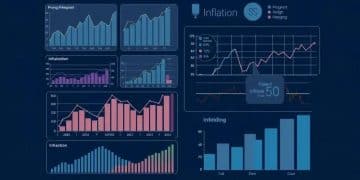Federal Student Loan Rates 2025: What Borrowers Need to Know

Understanding the new federal student loan interest rates for 2025 is crucial for current and prospective borrowers to effectively plan and manage their educational financing and repayment strategies.
Are you wondering how the upcoming changes to federal student loan rates in 2025 will impact your financial future? Navigating the complexities of student loan interest rates can be daunting, but staying informed is your best defense against unexpected financial burdens. This comprehensive guide aims to demystify these changes, providing clarity and actionable insights for both current and prospective borrowers.
the mechanics of federal student loan interest rates
Federal student loan interest rates are not static; they are set by Congress annually and are tied to financial markets. These rates are fixed for the life of the loan once disbursed, meaning the rate you receive for a loan in 2025 will remain the same until it’s paid off. Understanding how these rates are determined is the first step in comprehending their impact on your borrowing.
The rates are typically determined by the 10-year Treasury note auction, plus a statutory add-on. This linkage ensures that federal loan rates generally reflect broader economic conditions, though they are often lower than private loan rates due to government subsidies and borrower protections. For instance, different loan types, such as Direct Subsidized, Direct Unsubsidized, and PLUS loans, will carry distinct interest rates.
how rates are set annually
Each spring, Congress reviews the 10-year Treasury note auction results from the preceding May. The interest rate for new federal student loans disbursed between July 1 of that year and June 30 of the following year is then set. This annual reset means that borrowers taking out loans in different academic years might have different interest rates, even for the same loan type. This mechanism is designed to provide consistency for borrowers within a given academic year while allowing rates to adjust to economic realities over time.
- Treasury Note Auction: The benchmark for federal student loan rates.
- Statutory Add-on: A fixed percentage added to the Treasury yield.
- Fixed Rates: Once disbursed, your interest rate will not change.
- Annual Review: Rates are reset each spring for the upcoming academic year.
The process ensures that while rates are responsive to market conditions, they also offer a degree of predictability for borrowers. It’s crucial for students and parents to monitor these announcements, especially if they anticipate needing federal student loans for the 2025-2026 academic year. Staying informed about these annual adjustments can help you budget and plan your educational expenses more effectively.
projected changes in 2025 and their implications
As we approach 2025, many borrowers are keenly watching for projections regarding the new federal student loan interest rates. While official rates are not announced until late spring, economic indicators and historical trends can offer some insights. Factors such as inflation, the Federal Reserve’s monetary policy, and the overall economic landscape play significant roles in shaping these projections.
Economists and financial analysts often forecast interest rate movements based on these macroeconomic factors. A rising inflation environment, for example, typically leads to higher interest rates across the board, including for student loans. Conversely, a slowing economy might prompt policymakers to keep rates stable or even lower them to stimulate growth. These projections, while not guarantees, provide a valuable framework for anticipating potential changes.
impact on different loan types
The changes in interest rates will affect various federal loan types differently. Direct Subsidized Loans, available to undergraduate students with demonstrated financial need, historically have lower rates or offer interest subsidies while the student is in school. Direct Unsubsidized Loans, available to both undergraduate and graduate students regardless of financial need, and Direct PLUS Loans (for graduate students and parents) generally carry higher rates.
- Direct Subsidized Loans: May see minimal rate increases or continued subsidies.
- Direct Unsubsidized Loans: Likely to reflect broader market rate changes.
- Direct PLUS Loans: Often have the highest rates among federal options, making rate increases more impactful.
For borrowers, even a small percentage increase can translate into thousands of dollars over the life of a loan. Therefore, understanding these projected changes and their specific impact on the loan types you hold or plan to take out is essential for effective financial planning. It’s not just about the upfront rate, but the cumulative cost over many years of repayment.
strategies for managing new interest rates
With potential shifts in federal student loan interest rates for 2025, borrowers need proactive strategies to manage their debt effectively. Understanding your options and acting decisively can mitigate the impact of higher rates and help you save money over time. This involves a combination of smart borrowing, diligent repayment, and exploring available programs.
One primary strategy is to borrow only what you absolutely need. Every dollar borrowed accrues interest, so minimizing your principal balance is always beneficial. Additionally, making interest payments while in school, if possible, can prevent interest from capitalizing and increasing your total loan amount. These small steps can make a significant difference in the long run.
repayment plan options and their benefits
The federal student loan system offers various repayment plans designed to accommodate different financial situations. Income-Driven Repayment (IDR) plans, for example, adjust your monthly payments based on your income and family size, potentially lowering your payment and extending your repayment period. Other options include the Standard Repayment Plan, Graduated Repayment Plan, and Extended Repayment Plan.
- Income-Driven Repayment (IDR): Payments based on income, typically 10-20% of discretionary income.
- Standard Repayment: Fixed payments over 10 years, generally leading to the lowest total cost.
- Graduated Repayment: Payments start low and increase every two years.
- Extended Repayment: Lower payments over a longer period (up to 25 years) for larger loan balances.
Choosing the right repayment plan is critical. For some, an IDR plan might provide necessary relief, while others might benefit from the faster repayment and lower overall cost of a Standard Plan. Regularly reviewing your financial situation and adjusting your repayment plan as needed is a smart approach to managing your student loan debt, especially in the face of changing interest rates.
the role of consolidation and refinancing
For borrowers with multiple federal student loans, consolidation can simplify repayment by combining them into a single loan with one monthly payment. While federal loan consolidation typically uses a weighted average of your existing rates, it can sometimes offer a slightly lower overall rate, especially if you have older loans with higher rates. More importantly, it can open doors to different repayment plans and potentially extend your repayment term, reducing your monthly payment.
Refinancing, on the other hand, involves taking out a new private loan to pay off your existing federal and/or private student loans. This is often pursued to secure a lower interest rate, especially for borrowers with excellent credit and stable income. However, refinancing federal loans into a private loan means losing access to federal benefits like income-driven repayment plans, deferment, forbearance, and potential loan forgiveness programs. This trade-off must be carefully considered.
when to consider consolidation
Federal loan consolidation might be beneficial if you are struggling with multiple monthly payments, want to simplify your finances, or need to qualify for certain income-driven repayment plans or public service loan forgiveness (PSLF) that some older federal loans might not have been eligible for. It can also be a good option if you want to extend your repayment period to lower your monthly payment, though this will likely increase the total interest paid over time.
- Simplify Payments: One monthly bill instead of several.
- Access New Repayment Plans: Eligibility for IDR or PSLF.
- Extend Term: Lower monthly payments, but more interest paid overall.
Before consolidating, it’s vital to understand that your interest rate will be the weighted average of your current rates, rounded up to the nearest one-eighth of a percentage point. This means consolidation might not significantly lower your interest rate, but it can provide administrative convenience and access to other federal benefits. Always weigh the pros and cons carefully to ensure it aligns with your financial goals.
understanding loan forgiveness programs
Federal student loan forgiveness programs offer a lifeline to many borrowers, potentially erasing a portion or even the entirety of their student debt under specific conditions. These programs are designed to incentivize careers in public service, assist borrowers experiencing financial hardship, or provide relief in other qualifying circumstances. Staying informed about these programs is crucial, especially with changing interest rates, as they can significantly alter your repayment landscape.
The most well-known program is Public Service Loan Forgiveness (PSLF), which forgives the remaining balance on Direct Loans after 120 qualifying monthly payments are made under a qualifying repayment plan while working full-time for a qualifying employer. Other programs exist for specific professions, such as teachers, nurses, and doctors, often requiring service in underserved areas. Additionally, certain income-driven repayment plans offer forgiveness of remaining balances after 20 or 25 years of payments.
key forgiveness programs to explore
Beyond PSLF, several other federal programs can provide relief. Teacher Loan Forgiveness, for example, can forgive up to $17,500 for eligible teachers who work for five consecutive years in low-income schools. There are also specific programs for borrowers with permanent disabilities, or those whose schools closed, or who were victims of fraud by their institution. Each program has unique eligibility criteria and application processes.
- Public Service Loan Forgiveness (PSLF): Forgiveness after 10 years of qualifying public service payments.
- Teacher Loan Forgiveness: Up to $17,500 for eligible teachers in low-income schools.
- Income-Driven Repayment (IDR) Forgiveness: Remaining balance forgiven after 20 or 25 years of payments.
- Discharge Options: For permanent disability, school closure, or borrower defense to repayment.

It’s important to regularly check your eligibility for these programs and ensure you are meeting all requirements. Many borrowers miss out on forgiveness opportunities simply because they are unaware of the options or fail to track their progress diligently. The rules can be complex, so seeking guidance from a financial advisor or directly from your loan servicer is often recommended to ensure you are on the right path.
expert tips for future borrowers
For those contemplating taking out federal student loans for the first time in 2025, a strategic approach can make a significant difference in your long-term financial health. The landscape of student borrowing is constantly evolving, and being prepared means understanding not just the current rates, but also the broader implications of your borrowing decisions. It’s about making informed choices that align with your educational and career goals.
Start by maximizing grants, scholarships, and federal aid that doesn’t need to be repaid. These are the best forms of financial assistance. Only after exhausting these options should you consider federal student loans. When borrowing, prioritize Direct Subsidized Loans first, as they offer better terms for those with financial need. Always be mindful of the total amount you are borrowing and how it will translate into monthly payments after graduation.
making informed borrowing decisions
Before committing to any loan, thoroughly research the interest rates and terms. Use online calculators to estimate your future monthly payments and total interest paid over the life of the loan. Consider your expected post-graduation income and how your loan payments will fit into your budget. It’s also wise to understand the difference between federal and private loans, recognizing the unique benefits and protections that federal loans offer.
- Maximize Free Aid: Grants and scholarships should be your first priority.
- Prioritize Federal Loans: Leverage the benefits and protections of federal aid.
- Understand Loan Terms: Know your interest rate, repayment period, and total cost.
- Budget for Repayment: Estimate future payments against projected income.
Engage with your school’s financial aid office. They are invaluable resources for understanding your options, completing the FAFSA, and navigating the complexities of financial aid. Their expertise can help you make the best borrowing decisions for your unique circumstances, ensuring you avoid unnecessary debt and set yourself up for financial success after graduation.
navigating repayment challenges
Even with careful planning, borrowers can face unexpected challenges during repayment. Job loss, medical emergencies, or other financial setbacks can make it difficult to meet monthly student loan obligations. The federal student loan system offers several options to help borrowers navigate these difficult periods, providing temporary relief and preventing default.
Forbearance and deferment are two key options that allow you to temporarily postpone or reduce your loan payments. Deferment is often available for specific situations like unemployment, economic hardship, or returning to school, and interest may not accrue on subsidized loans during this period. Forbearance, while also pausing payments, typically allows interest to accrue on all loan types, which can increase your total loan cost over time. Understanding the differences and implications of each is crucial.
options for temporary relief
If you find yourself struggling, don’t wait until you miss a payment. Contact your loan servicer immediately to discuss your options. They can help you understand eligibility for deferment or forbearance, or guide you toward an income-driven repayment plan that might lower your monthly payments to a more manageable level. Proactive communication is key to avoiding default and protecting your credit score.
- Deferment: Postpone payments, interest may not accrue on subsidized loans.
- Forbearance: Postpone payments, interest accrues on all loan types.
- Income-Driven Repayment (IDR): Adjust payments based on income and family size.
- Loan Servicer Communication: Contact them early if you anticipate payment difficulties.
Exploring these options can provide the breathing room you need to get back on your feet financially without severely impacting your credit or facing the serious consequences of loan default. The federal system is designed with these safety nets in mind, but it’s up to the borrower to utilize them wisely and responsibly.
| Key Aspect | Brief Description |
|---|---|
| Interest Rate Setting | Federal rates are fixed annually by Congress, tied to the 10-year Treasury note. |
| Borrower Impact | Changes in rates affect total cost and monthly payments, varying by loan type. |
| Repayment Strategies | Utilize IDR plans, consolidation, or explore refinancing for better terms. |
| Forgiveness Programs | PSLF and other programs offer debt relief for qualifying service or circumstances. |
frequently asked questions about federal student loan rates
Federal student loan interest rates for 2025 are set by Congress each spring, based on the results of the 10-year Treasury note auction from the preceding May, plus a statutory add-on. These rates are fixed for the life of the loan once disbursed.
No, federal student loan interest rates are fixed. The rate you received at the time of your loan’s disbursement will remain the same. The new 2025 rates will only apply to new loans disbursed between July 1, 2025, and June 30, 2026.
IDR plans adjust your monthly federal student loan payments based on your income and family size, making them more affordable. They can be crucial if you’re struggling with payments, and some plans offer loan forgiveness after 20 or 25 years of payments.
Federal loan consolidation simplifies payments and can open access to certain programs. Refinancing with a private lender might offer a lower rate but means losing federal benefits. Evaluate your financial situation and goals carefully before making a decision.
Yes, programs like Public Service Loan Forgiveness (PSLF) and Teacher Loan Forgiveness can provide significant debt relief. Various income-driven repayment plans also offer forgiveness after a certain period. Research eligibility requirements and track your progress diligently.
conclusion
As we’ve explored, understanding the new federal student loan interest rates for 2025 and the broader landscape of student financing is paramount for effective debt management. From the annual rate-setting mechanisms to strategic repayment options, consolidation, and the availability of forgiveness programs, borrowers have various tools at their disposal. Proactive planning, informed decision-making, and continuous engagement with your loan servicer are key to navigating your student loan journey successfully. By staying informed and utilizing available resources, you can mitigate financial stress and move confidently toward your financial goals.





